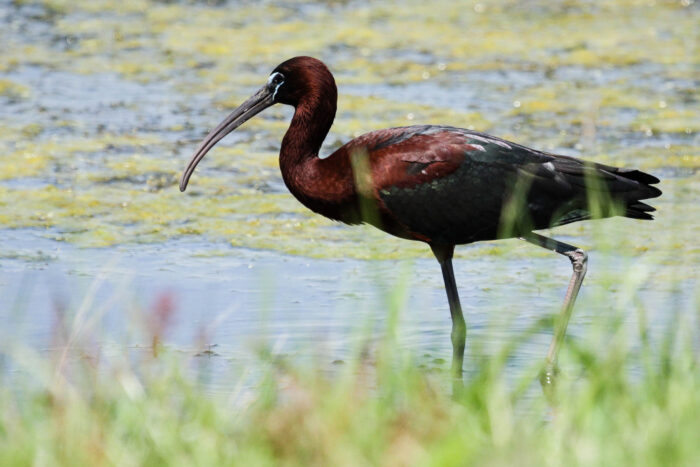Glossy Ibis
Plegadis falcinellus
The glossy ibis is a heron-like wading bird with dark green and purple plumage. It visits Chesapeake Bay marshes and wetlands from spring through autumn.
This section shows one large critter image at a time. Use the thumbnails that follow to select a specific image to display here.

This gallery contains a grid of small thumbnails. Selecting a thumbnail will change the main image in the preceding section.
Appearance
From early spring to mid-summer, adults are in breeding plumage: a chestnut head, neck, upper back and underparts, and metallic green and purple wings and tail. Breeding adults also have pale blue skin along the edges of the base of the bill. Adults in nonbreeding plumage are duller in color, with white streaks on the head and neck. The glossy ibis' long, slender, dark gray bill curves downward at the tip. It has long, dark grayish-green legs. It grows to 25 inches with a wingspan of 36 inches.
Feeding
The glossy ibis feeds on insects, small fish and aquatic invertebrates, including mollusks and fiddler crabs. It uses its long bill to probe through mud and shallow water to find prey.
Flight
The glossy ibis flies with an outstretched neck. This differs from the flight behavior of herons and egrets, which have crooks in their necks when they fly. It often flies in groups that synchronize gliding and wingbeats.
Voice
This bird makes a low kruk or ka-honk sound.
Reproduction and life cycle
The glossy ibis nests in breeding colonies on islands, including Smith Island in Tangier Sound; it will sometimes nest in mixed colonies with herons. It builds nests of sticks and twigs in bushes and low trees, usually over the water. Females lay three to four eggs, which both the male and female incubate until they hatch approximately three weeks later. Chicks fledge about 25 to 28 days later, although they aren’t independent from their parents for another three to four weeks.
Did you know?
- Their scientific name, Plegadis falcinellus, means “scythe” or “sickle,” referring to the bird’s distinctive downcurved bill.
- The glossy ibis is the most widespread ibis species in the world.
Sources and additional information
- Life in the Chesapeake Bay by Alice Jane Lippson and Robert L. Lippson
- Chesapeake Bay: Nature of the Estuary, A Field Guide by Christopher P. White
- All About Birds: Glossy Ibis – The Cornell Lab of Ornithology
